DELAFIELD, Wis. (Stockpickr) -- Trading stocks that trigger major breakouts can lead to massive profits. Once a stock trends to a new high or takes out a prior overhead resistance point, then it's free to find new buyers and momentum players who can ultimately push the stock significantly higher.
>>5 Stocks Under $10 Set to Soar
One successful breakout trade that I flagged recently was cancer diagnostics player Biocept (BIOC), which I featured on June 13 at $5.70 per share. I mentioned then that shares of Biocept gapped up sharply higher back above its 50-day moving average of $5.13 a share with strong upside volume. That move was quickly pushing shares of BIOC within range of triggering a major breakout trade above some key near-term overhead resistance levels at $5.85 to $6 a share.
Guess what happened? Shares Biocept triggered that breakout on June 18 with heavy upside volume. Volume on that day registered 124,000 shares, which is well above its three-month average action of 27,117 shares. Shares of BIOC have continued to uptrend since breaking out that day, with the stock tagging an intraday high on Friday of $7.72 a share. That represents a large gain of over 30% in just a few trading sessions for anyone who bought shares of BIOC in anticipation of that breakout.
>>5 Blue-Chip Stocks to Trade for Gains
Breakout candidates are something that I tweet about on a daily basis. I frequently tweet out high-probability setups, breakout plays and stocks that are acting technically bullish. These are the stocks that often go on to make monster moves to the upside. What's great about breakout trading is that you focus on trend, price and volume. You don't have to concern yourself with anything else. The charts do all the talking.
Trading breakouts is not a new game on Wall Street. This strategy has been mastered by legendary traders such as William O'Neal, Stan Weinstein and Nicolas Darvas. These pros know that once a stock starts to break out above past resistance levels and hold above those breakout prices, then it can easily trend significantly higher.
>>A Small-Cap Stock With Big Upside Potential
With that in mind, here's a look at five stocks that are setting up to break out and trade higher from current levels.
Controladora Vuela Compa
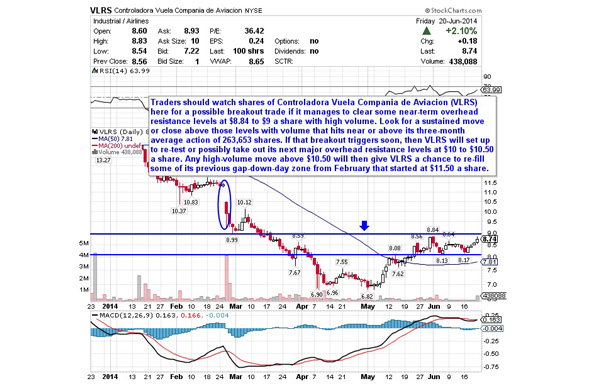
One regional airline player that's quickly moving within range of triggering a big breakout trade is Controladora Vuela Compa (VLRS), which provides air transportation services for passengers, cargo and mail in Mexico and internationally. This stock is off to a weak start in 2014, with shares down sharply by 35%.
>>5 Stocks With Big Insider Buying
If you take a look at the chart for Controladora Vuela Compa, you'll notice that this stock recently formed a double bottom chart pattern at $8.13 to $8.17 a share. That bottom occurred right above its 50-day moving average. Since forming that bottom, shares of VLRS have now started to uptrend and break out above some near-term overhead resistance at $8.64 a share. That move is quickly pushing shares of VLRS within range of triggering a much bigger breakout trade above some key near-term overhead resistance levels.
Traders should now look for long-biased trades in VLRS if it manages to break out above some near-term overhead resistance levels at $8.84 to $9 a share with high volume. Look for a sustained move or close above those levels with volume that hits near or above its three-month average volume of 264,347 shares. If that breakout gets underway soon, then VLRS will set up to re-test or possibly take out its next major overhead resistance levels at $10 to $10.50 a share. Any high-volume move above $10.50 a share will then give VLRS a chance to re-fill some of its previous gap-down-day zone from February that started at $11.50 a share.
Traders can look to buy VLRS off weakness to anticipate that breakout and simply use a stop that sits right below those double bottom support zones or around its 50-day moving average of $7.81 a share. One can also buy VLRS off strength once it starts to take out those breakout levels with volume and then simply use a stop that sits a comfortable percentage from your entry point.
Novavax
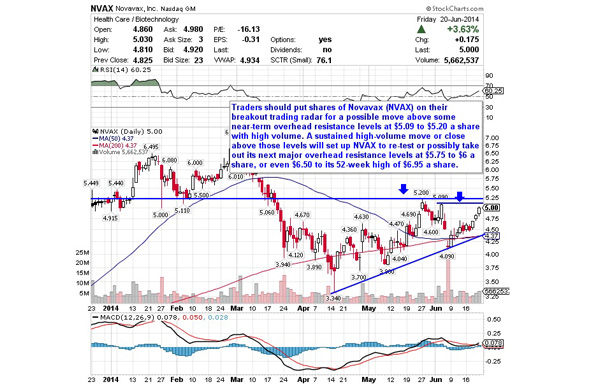
A clinical-stage biopharmaceutical player that's starting to trend within range of triggering a big breakout trade is Novavax (NVAX), which focuses on discovering, developing and commercializing recombinant protein nanoparticle vaccines and adjuvants. This stock hasn't done much over the last three months, with shares up around 7%.
>>3 Big Stocks Getting Big Attention
If you take a look at the chart for Novavax, you'll see that this stock recently gapped down back below both its 50-day and 200-day moving averages with heavy downside volume. Following that gap, shares of NVAX have started to rebound higher with the stock moving back above those key moving averages and with NVAX now quickly moving within range of triggering a big breakout trade above some key near-term overhead resistance levels.
Traders should now look for long-biased trades in NVAX if it manages to break out above some near-term overhead resistance levels at $5.09 to $5.20 a share with high volume. Look for a sustained move or close above those levels with volume that registers near or above its three-month average action of 4.70 million shares. If that breakout begins soon, then NVAX will set up to re-test or possibly take out its next major overhead resistance levels at $5.75 to $6 a share, or even $6.50 to its 52-week high of $6.95 a share.
Traders can look to buy NVAX off weakness to anticipate that breakout and simply use a stop that sits right below its 50-day moving average of $4.37 a share or around more support at $4.09 a share. One could also buy NVAX off strength once it starts to clear those breakout levels with volume and then simply use a stop that sits a comfortable percentage from your entry point.
Allscripts Healthcare Solutions
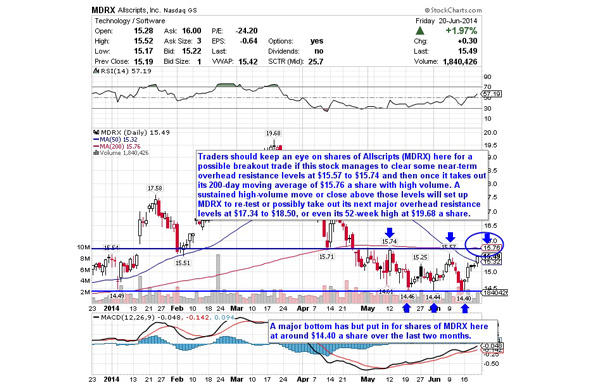
Another stock that's starting to move within range of triggering a near-term breakout trade is Allscripts Healthcare Solutions (MDRX), which is a provider of clinical, financial, connectivity and information solutions and related professional services to hospitals, physicians and post-acute organizations. This stock has been under some selling pressure over the last three months, with shares off by 18%.
>>4 Biotech Stocks Under $10 to Watch for Breakout Trades
If you take a glance at the chart for Allscripts Healthcare Solutions, you'll notice that this stock recently formed a major bottoming chart pattern, since shares have found buying interest each time it has pulled back to around $14.60 to $14.40 a share. Shares of MDRX have now started to spike higher above those support levels and its trending back above its 50-day moving average of $15.32 a share. That move is quickly pushing shares of MDRX within range of triggering a near-term breakout trade above some key overhead resistance levels.
Traders should now look for long-biased trades in MDRX if it manages to break out above some near-term overhead resistance levels at $15.57 to $15.74 a share and then once it takes out its 200-day moving average of $15.76 a share with high volume. Watch for a sustained move or close above those levels with volume that hits near or above its three-month average action of 1.68 million shares. If that breakout triggers soon, then MDRX will set up to re-test or possibly take out its next major overhead resistance levels at $17.34 to $18.50 a share, or even its 52-week high of $19.68 a share.
Traders can look to buy MDRX off weakness to anticipate that breakout and simply use a stop that sits just below some near-term support at $15 a share or around those major support zones at $14.60 to $14.40 a share. One can also buy MDRX off strength once it starts to move above those breakout levels share with volume and then simply use a stop that sits a comfortable percentage from your entry point.
Idera Pharmaceuticals
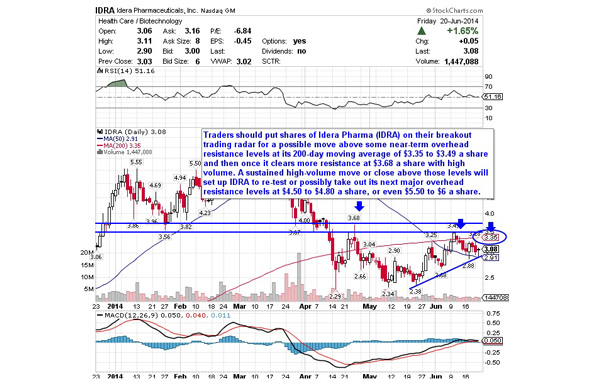
Another stock that's starting to trend within range of triggering a major breakout trade is Idera Pharmaceuticals (IDRA), which is engaged in the discovery and development of novel therapeutics that modulate immune responses through toll-like receptors in the U.S. This stock has been hit hard by the bears so far in 2014, with shares off sharply by 33%.
>>4 Stocks Breaking Out on Big Volume
If you take a glance at the chart for Idera Pharmaceuticals, you'll notice that this stock has been uptrending a bit for the last month and change, with shares moving higher from its low of $2.34 to its recent high of $3.49 a share. During that uptrend, shares of IDRA have been making mostly higher lows and higher highs, which is bullish technical price action. That move has now pushed shares of IDRA within range of triggering a major breakout trade above some key near-term overhead resistance levels.
Traders should now look for long-biased trades in IDRA if it manages to break out above some near-term overhead resistance levels at $3.35 to $3.49 a share and then once it takes out more key resistance at $3.68 a share with high volume. Look for a sustained move or close above those levels with volume that hits near or above its three-month average volume of 2.88 million shares. If that breakout materializes soon, then IDRA will set up to re-test or possibly take out its next major overhead resistance levels at $4.50 to $4.80 a share, or even $5.50 to $6 a share.
Traders can look to buy IDRA off weakness to anticipate that breakout and simply use a stop that sits right below some key near-term support levels at $2.68 or at $2.30 a share. One can also buy IDRA off strength once it starts to bust above those breakout levels with volume and then simply use a stop that sits a comfortable percentage from your entry point.
Ohr Pharmaceutical
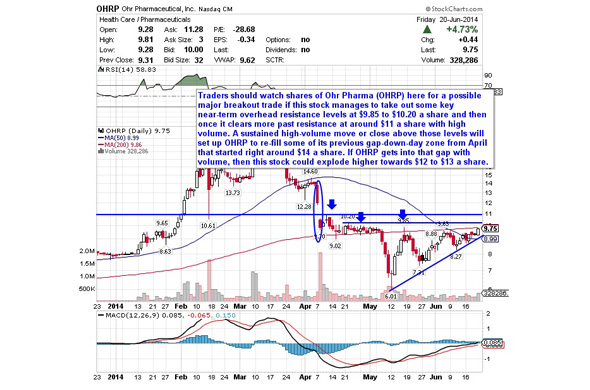
My final breakout trading prospect is biotechnology player Ohr Pharmaceutical (OHRP), which focuses on the development of its two products: OHR/AVR118 for the treatment of cancer cachexia and Squalamine for the treatment of the wet form of age-related macular degeneration using an eye drop formulation. This stock has been blasted by the sellers over the last three months, with shares off by 41%.
If you look at the chart for Ohr Pharmaceutical, you'll see that this stock has been uptrending strong for the last month and change, with shares pushing higher from its low of $6.01 to its recent high of $9.85 a share. During that uptrend, shares of OHRP have been making mostly higher lows and higher highs, which is bullish technical price action. Shares of OHRP have now started to spike higher right above its 50-day moving average of $8.99 a share with strong upside volume. That spike is starting to push shares of OHRP within range of triggering a major breakout trade above some key overhead resistance levels.
Traders should now look for long-biased trades in OHRP if it manages to break out above some near-term overhead resistance at $9.85 to $10.20 a share and then once it clears more past resistance at around $11 a share with high volume. Look for a sustained move or close above those levels with volume that registers near or above its three-month average action of 275,619 shares. If that breakout kicks off soon, then OHRP will set up to re-fill some of its previous gap-down-day zone from April that started right around $14 a share. If OHRP gets into that gap with strong volume, then it could easily explode higher towards $12 to $13 a share.
Traders can look to buy OHRP off weakness to anticipate that breakout and simply use a stop that sits right below its 50-day moving average of $8.99 a share or around more key support levels at $8.27 to $8 a share. One can also buy OHRP off strength once it starts to clear those breakout levels with volume and then simply use a stop that sits a conformable percentage from your entry point.
To see more breakout candidates, check out the Breakout Stocks of the Week portfolio on Stockpickr.
-- Written by Roberto Pedone in Delafield, Wis.
RELATED LINKS:
>>Move In to Hedge Funds' 5 Favorite REITs This Summer
>>5 Retail Stocks to Trade for Gains in June
>>2 Big-Volume Tech Stocks to Keep on Your Radar
Follow Stockpickr on Twitter and become a fan on Facebook.
At the time of publication, author had no positions in stocks mentioned.
Roberto Pedone, based out of Delafield, Wis., is an independent trader who focuses on technical analysis for small- and large-cap stocks, options, futures, commodities and currencies. Roberto studied international business at the Milwaukee School of Engineering, and he spent a year overseas studying business in Lubeck, Germany. His work has appeared on financial outlets including
CNBC.com and Forbes.com. You can follow Pedone on Twitter at www.twitter.com/zerosum24 or @zerosum24. The faces of minimum wage NEW YORK (CNNMoney) The New Year will start well for over 3 million workers -- they're getting a raise.
The faces of minimum wage NEW YORK (CNNMoney) The New Year will start well for over 3 million workers -- they're getting a raise.  Don Marron Bloomberg News
Don Marron Bloomberg News  for The Wall Street Journal
for The Wall Street Journal 


 Piper Jaffray initiated coverage of Recommended List selection LeapFrog (LF), starting the stock with an "overweight" rating. Analyst Stephanie Wissink placed an $11 price target on the stock.
Piper Jaffray initiated coverage of Recommended List selection LeapFrog (LF), starting the stock with an "overweight" rating. Analyst Stephanie Wissink placed an $11 price target on the stock.

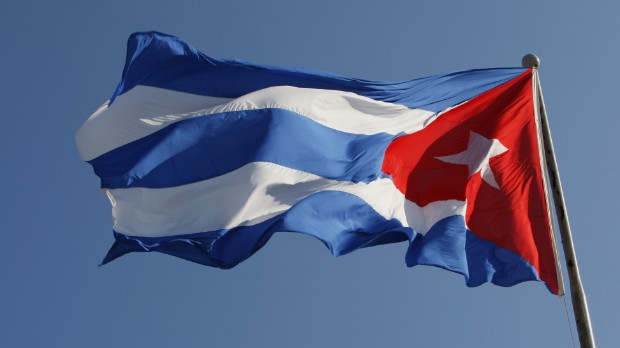 What you need to know about the Cuban embargo NEW YORK (CNNMoney) Trade with Cuba has been blocked for decades, but nearly $2 billion was sent to Cubans last year from within the United States.
What you need to know about the Cuban embargo NEW YORK (CNNMoney) Trade with Cuba has been blocked for decades, but nearly $2 billion was sent to Cubans last year from within the United States.  Now americans can send up to $8,000 a year to Cuba.
Now americans can send up to $8,000 a year to Cuba. 

